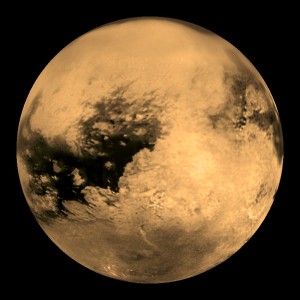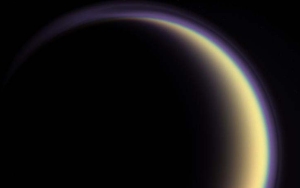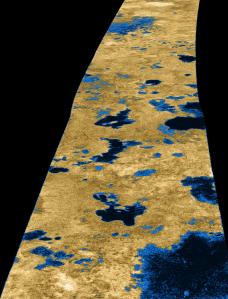Terrific Titan
Titan, Saturn’s largest moon (and second largest in the solar system), is a really cool world. Like Earth, it has a thick atmosphere, making it the only moon in our solar system to have one. Also, like Earth, Titan’s atmosphere is mostly composed of nitrogen, and has a presence of organic molecules that contain carbon and hydrogen. This has led many scientists to speculate that current conditions on Titan are like those during the early years of Earth. One major difference, however, is that because Titan is so cold,-290 F or -179 C, water is frozen as solid as a rock, but methane and ethane can be found in liquid form. In fact, similar to Earth’s water cycle, Titan has the phenomenon of a hydrocarbon cycle, in which liquid methane and ethane fall to the surface. In 2005, the Huygens probe was released by the Cassini spacecraft down to Titan’s surface, and pictures taken during the descent show that Titan’s polar region even has lakes and rivers filled with liquid methane.
What’s great about Titan is that it’s still making headlines. One new discovery has to do with the moon’s atmosphere. Back in 2009, Cassini spotted a glow emanating from Titan’s atmosphere. The emission comes from a mysterious gas and is strongest at an infrared wavelength of 3.28 micrometers, near one where emissions from methane are also very strong, one reason why these mystery emissions were previously obscured. The glow only appears on the moon’s daytime side, at altitudes between 600 and 1250 km, with the largest intensity occurring around 950 km. Normally, this light, known as airglow, is generated when atmospheric molecules are excited by sunlight or electrically charged particles. Therefore, scientists expected to see a glow in the high atmosphere because there, charged particles from the Sun and Saturn’s magnetic field strip away electrons from molecules in Titan’s atmosphere. The deeper glow (below 700 km), however, has puzzled researchers, because it originates too far down to be caused by the excitation of atmospheric molecules by charged particles. Perhaps the glow is produced by deep-penetrating cosmic rays or by light emitted by a chemical reaction deep in Titan’s atmosphere. Unfortunately, we still don’t know the glow’s cause, nor the chemical composition of the gas, for sure.
The second bit of news regarding Titan concerns its methane lakes. Apparently, we probably wouldn’t want to sail the Titanic through those waters either, because there may be chunks of hydrocarbon ice floating in them. Scientists first believed that methane ice on these seas would not be possible, as solid methane is denser than the liquid form. However, after a model investigating how Titan’s seas interact with its nitrogen-rich atmosphere (which creates pockets of varying composition and temperature) was created, scientists determined that hydrocarbon ice should indeed float in the moon’s seas, so long as the temperature is just below methane’s freezing point (-297 degrees F or -183 degrees C) and the ice is at least 5 percent “air”. That ice may only last a short time, however, as even a small drop in temperature would cause the ice to sink. The research team will be able to test out their model soon, as Titan’s northern spring is underway, warming up the lakes and seas there and allowing ice to rise to the surface. This in turn will create a surface that appears “brighter”, or more reflective, to Cassini and as the temperature increases further, the ice will melt, leaving an entirely liquid surface that will appear “darker”, or less reflective. As one researcher put it, the discovery that ice could form is important because “…the formation of floating hydrocarbon ice will provide an opportunity for interesting chemistry along the boundary between liquid and solid, a boundary that may have been important in the origin of terrestrial life.”
Hopefully, we’ll make even more discoveries about this fascinating world in the years to come, and hey, who knows, maybe one day we’ll even get to swim in those methane lakes ourselves.



I really enjoyed this post. Saturn is my favourite planet and Titan is my favourite moon. I personally think that Titan could be used as a huge bio-sphere for experimentation with engineered life given its suitable conditions. Perhaps we could develop microbial life forms that could alter any world’s atmosphere to make it suitable for humans.
I really liked the images you included in this post! I think Titan is one of the more beautiful worlds in the solar system. I’d never heard about Titan’s atmospheric glow before, but that was really interesting.